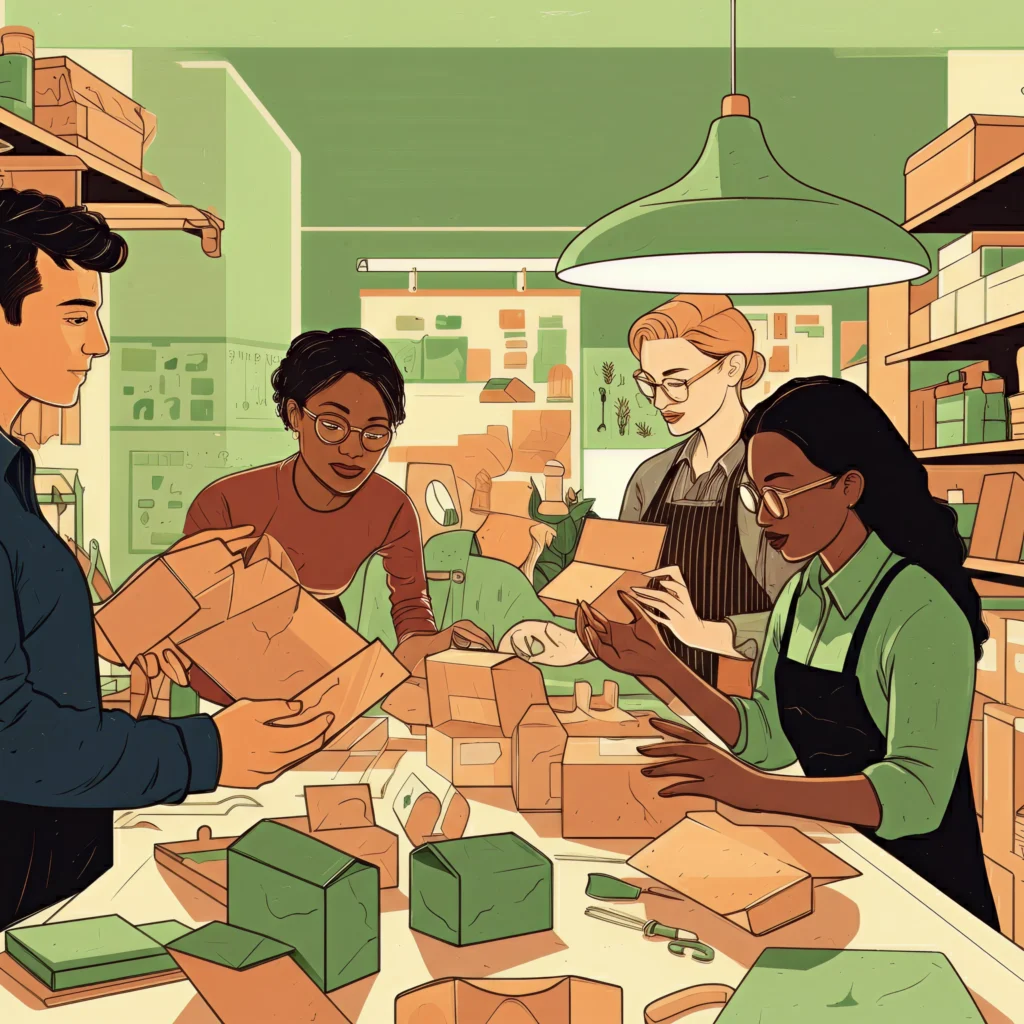Sustainability is no longer just a buzzword; it’s a critical consideration for businesses and consumers alike. With industries striving to reduce their environmental impact, eco-friendly packaging has emerged as a key area of focus. For businesses, choosing sustainable packaging solutions not only helps protect the planet but also resonates with eco-conscious customers who value responsible practices.

If you’re unsure how to ensure your packaging is both eco-friendly and practical, this guide will help you understand the fundamentals, actionable steps, and benefits of adopting sustainable packaging practices.
Understanding Eco-Friendly Packaging
Before developing eco-friendly packaging solutions, it’s essential to fully grasp what “eco-friendly” or “sustainable” means in this context.
What Does “Eco-Friendly” Mean in Packaging?
Eco-friendly packaging refers to materials and designs that minimize harm to the environment while remaining functional for their intended purpose. These can include recyclable, biodegradable, compostable, or reusable materials. True sustainability ensures that the production process, use, and disposal of the packaging leave a minimal carbon footprint and conserve resources.
Types of Sustainable Packaging Materials
Here are some materials commonly used in sustainable packaging solutions:
- Recycled Cardboard: Crafted from post-consumer materials, recycled cardboard reduces the need for virgin wood pulp, making it a favorite for shipping boxes and cartons.
- Biodegradable Plastics: These plastics break down naturally over time, reducing plastic waste in landfills and oceans. Look for PLA (polylactic acid) or PHA (polyhydroxyalkanoate) options.
- Molded Fiber: A great alternative to Styrofoam, molded fiber is used for packaging fragile items and is typically made from fibers like wood or bagasse (sugarcane residue).
- Corrugated Materials: These lightweight yet durable boards are sourced from natural fibers and typically recyclable.
- Compostable Packaging Films: Ideal for food and retail packaging, these films are plant-based and decompose safely in composting environments.
Now that you’ve identified sustainable material options, how can you make sure your packaging choices align with your eco-friendly vision?
Steps to Ensure Your Packaging Is Eco-Friendly
Step 1: Conduct a Packaging Audit
The first step is to evaluate your current packaging. Ask yourself:
- What materials are you using?
- Are these materials recyclable or biodegradable?
- How much waste are you generating in production, distribution, or post-use?
Identify areas of improvement by tracking your packaging supply chain and pinpointing waste-generation hotspots. Additionally, gather customer feedback to understand their perception of your current packaging.
Step 2: Choose Sustainable Materials
Using eco-friendly materials is one of the most direct ways to make your packaging sustainable. Invest in materials that align with industry standards for recyclability and compostability. Certifications to look for include:
- FSC (Forest Stewardship Council) Certification for responsibly sourced paper and wood products.
- Compostable and biodegradable certifications from recognized agencies like BPI or TUV.
While working with sustainable materials can require in-depth research, consider partnering with packaging experts who specialize in eco-conscious solutions.
Step 3: Optimize Packaging Size & Weight
Overpackaging not only increases waste but also adds to shipping costs and emissions.
- Design packaging that perfectly fits your product dimensions to minimize material use.
- Switch to lightweight materials wherever possible without compromising durability.
For example, many e-commerce companies have adopted smaller, snug-fit boxes and eliminated unnecessary filler materials to enhance sustainability and improve the customer unboxing experience.
Step 4: Work with Eco-Conscious Suppliers
Your suppliers play a crucial role in your packaging’s sustainability. Partner with those committed to green practices, whether it’s sourcing recycled raw materials or decreasing greenhouse gas emissions. Request certifications and proof of sustainability from potential vendors to confirm their compliance with globally recognized standards.
Step 5: Educate Your Customers
Customer behavior also determines the end life of your packaging. Help them make environmentally responsible choices by:
- Printing clear recycling instructions on your packaging.
- Highlighting steps for compostable products, e.g., “Compost in an industrial facility for best results.”
- Including QR codes linking to educational resources about sustainability.
Encourage your customers to reduce packaging waste by reusing boxes or returning them for recycling initiatives. Beyond boxes, reducing paper waste is crucial, especially when considering eco-friendly gift wrapping ideas for the holidays or special occasions.
Benefits of Eco-Friendly Packaging
Why should you invest in sustainable packaging? Here are three significant advantages to consider:
Positive Impact on the Environment
Eco-friendly packaging reduces carbon emissions, landfill waste, and toxins introduced into ecosystems. By switching to recycled or biodegradable materials, your business can indirectly save resources like water and energy.
Enhanced Brand Image and Customer Loyalty
Today’s consumers are increasingly sensitive to environmental ethics. A survey by IBM revealed that 57% of customers are willing to change their shopping habits to reduce environmental impact. By delivering sustainable packaging, your business demonstrates its values and builds trust with eco-conscious audiences.
Cost Savings in the Long Run
While upfront costs for sustainable materials may seem higher, they can lead to significant savings over time. Optimizing packaging design reduces material costs and shipping expenses. Plus, improved customer satisfaction and loyalty can result in long-term revenue growth.
Overcoming Challenges
Transitioning to sustainable packaging can be challenging, especially for businesses new to eco-friendly practices.
Addressing Common Concerns
One major concern is cost. While the initial expense of sustainable materials and processes might appear steep, innovations and economies of scale have made them increasingly affordable. For instance, compostable corrugated materials now compete price-wise with traditional packaging options.
Availability can also be a barrier. Some regions or industries might face limited access to suitable materials. However, expanding supplier networks and the growth of green technology are rapidly resolving these concerns.
Innovative Solutions and Emerging Technologies
Stay ahead of the curve by exploring new technologies in sustainable packaging. Examples include:
- Edible Packaging: Used in the food industry, these biodegradable options eliminate waste entirely.
- Smart Labels: Embedded with QR codes or NFC technology, they offer recycling instructions and traceability for improved end-of-life management.
- Plant-Based Alternatives: Materials like mushroom-based packaging and algae-derived plastic substitutes are growing in popularity.
The Future of Sustainable Packaging is Now
The shift toward eco-friendly packaging is no longer optional; it’s an integral part of modern business practices. By following these steps and integrating sustainable materials, designs, and partnerships into your packaging strategy, your business can positively impact the environment while building stronger connections with eco-conscious consumers.
If the idea of transforming your business packaging feels overwhelming, remember this change is a gradual but rewarding process. Begin with small adjustments, stay informed on sustainability advancements, and work with partners who share your goals.
Every step you take now will help you build a more sustainable future—for your business, your customers, and the planet.
